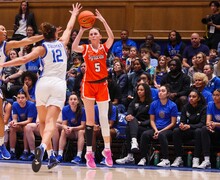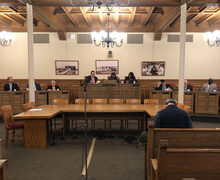Solve the mystery of what classes to take next semester
Jacqueline Simpson | Contributing Illustrator
MISS SCARLET
HST 222: “History of American Sexuality”
MWF 11:40-12:35
More than beauty lies within Miss Scarlet, the game’s resident femme fatale. She’s cunning and uses sexuality in her favor, simultaneously enchanting and outsmarting opponents.
Like Miss Scarlet, HST 222 aims to shift your perspective on sexuality, specifically in the United States. Carol Faulkner, the course professor, looks at history from the colonial period to present day.
“We tend to think that this is the most sexually liberated we have ever been, but that’s, in fact, not true,” Faulkner said. “The class communicates that we haven’t gotten more and more progressive over time, that there are definitely periods where we’ve moved backwards and shut down practices that have previously been opened up.”
The class explores questions of power and inequality as a way to understand the experience of race and gender in American history.
Faulkner said the class changes a bit every semester because the history is always evolving. Before, she used to end the class with the struggle for gay marriage, now she concludes with the impact of the decision to legalize marriage equality.
“You never know what topic may come up in any given semester,” Faulkner said.
MR. GREEN
REL 103: “Religion and Sports”
TIMES TBA
“Religion and Sports” is a solid choice for sports lovers in need of a class that fulfills a College of Arts and Sciences requirement. Learn the stories behind the creation of your favorite sports and the role they play within communities. The class builds on a foundation of defining religion as exchanges between people, animals, plants, ancestors and planets, according to the course syllabus.
In this class, you’ll delve into the relationship between teams and fans, coaches and players, and teams and their stadiums. You’ll also discuss the way sports help build a bond between kids and their communities. The class seeks to help students understand sports as ceremonial activities rather than purely entertainment, per the syllabus. A main of discussion is the origins of lacrosse because of its importance to the local Haudenosaunee community.
Other topics include issues relevant to today, like ethics, problems with mascots and diversity in sports.
COLONEL MUSTARD
PSC 398: “How the United States Became a Great Power”
T Th 11-12:20
Like Colonel Mustard, PSC 398 is a class that knows a thing or two about history. All it’s missing is that fabulous moustache. The class discusses how America became the power it is today. Covering the period between 1785 and 1900, this class reveals through readings how the United States went from being a 90-pound weakling to Arnold Schwarzenegger, said Colin Elman, who teaches the class.
“You begin in the 1770s and the 1780s as this small, fragile fragmented collection of newly independent political entities,” Elman said. “By the end of the 19th century, 120 years later, you are this enormously powerful soon-to-be most powerful country in the world.”
The class looks at America through the analytical perspective, asking questions about American exceptionalism, its relationship with Europe and the expansion. It also discusses why America stopped expanding at the Mexican and Canadian borders. While it may not have a candlestick in the drawing room, students are not required to purchase a textbook and there are 60 available slots for students.
PROFESSOR PLUM
NSD 225: “Nutrition in Health”
MW 3:45-5:05, W 5:15-8, T Th 11-12:20, T Th 3:30-4:50
Professor Plum, an archaeologist from Scotland, made a name for himself in academia with degrees from both Harvard and Oxford universities. But it doesn’t take a genius to know that eating healthy is a smart choice for anyone, and with this fruit-bearing last name of Plum in mind, let’s solve the mystery of what makes a good diet by taking a look at NSD 225: “Nutrition in Health.”
As professor Jane Burrell Uzcategui points out, 90 percent of Americans could make improvements to their diet. She’s been teaching NSD 225 here at Syracuse since 2009, and said every college student should take a nutrition course at some point.
“When you’re 19, 20, 21, you’re establishing habits that are going to affect your health in the long run,” she said.
SU doesn’t get a lot of majors studying this area —Uzcategui said between nutrition and nutrition science, there are usually fewer than 100 per class. So, to make her class more appealing and beneficial, she puts a personal spin on it. After an introduction of all the nutrients, the semester entails self-assessment activities to evaluate and analyze your diet. At the end of every semester, Uzcategui said there’s always at least one student that comes to her and claims the course helped them improve their diet and health. Mystery solved.
MRS. WHITE
CRS 360: Trump & Rhetoric and Popular Culture
MW 3:45-5:05
Mrs. White became a black widow after the mysterious death of her husband, an illusionist. The case was never solved and some suspect she was behind his sudden death, but she’s maintained her private demeanor, maybe because of a class that touches how to circulate information.
Professor Kendall Phillips will teach CRS 360: “Trump & Rhetoric and Popular Culture” this fall, a course that’s designed to get students thinking about the collision of two different realms.
“It’s really not going to be about policies,” Phillips said. “It’s really about the unique and not-so-unique intersections between the presidency and popular culture. We have a president for the first time ever that’s not a military leader or an elected official. The real reason we know him is his presence in popular culture.”
The three-credit class will discuss the current president, Donald Trump, in the context of how popular culture shapes the way we approach questions about policy and how popular culture can become resistant to official government. Besides that, the class will analyze media use, celebrity currency and how the two have been used by former presidents, like President Roosevelt’s use of radio and President Obama’s appearance on Zach Galifianakis’ show “Between Two Ferns.”
There will be a few short papers and quizzes, Phillips said.
“For students who are interested in popular culture but not politics, this will give them a different view of pop culture that’s not just about the media industry but as something that circulates,” he said. “For students who are interested in politics but not popular culture, this will be valuable because politics is not just about what happens behind closed doors, but about how things get circulated and talked about.”
MS. PEACOCK
ARI 563: “Painting: Art for Non-Majors”
TH 6-10
Ms. Peacock, according to Clue canon, studied fine arts at Boston University. For those looking to tap into their artistic side like Ms. Peacock, consider taking ARI 563: “Painting: Art for Non-Majors.” The class is a fundamentalist art course, perfect for beginners with no experience and intermediates looking to improve their skillset.
It runs on Thursday nights and is taught by Master of Fine Arts candidates. Owen Drysdale, a graduating master’s student concentrating in painting, has taught the class in previous semesters. The class usually starts with observational drawing, which can include still life and contour drawings. Then it moves more into painting.
“By the end of it, students will have the freedom to make whatever they want to,” he said.
Creating whatever the artist wants is a defining tenet of the course. Because it’s taught by graduate students, the curriculum can vary from instructor to instructor. Some might focus more heavily on drawing while others will stick to painting.
More experienced artists interested in the course will not find themselves unchallenged — Drysdale said he has worked with knowledgeable artists in the past, coming up with special projects so they wouldn’t get bored with the basics.
This is a free-flowing class that typically fills up quickly, but many students drop the course before getting to the meat of it because of the long studio hours, something to keep in mind.
Published on March 28, 2017 at 10:58 pm





